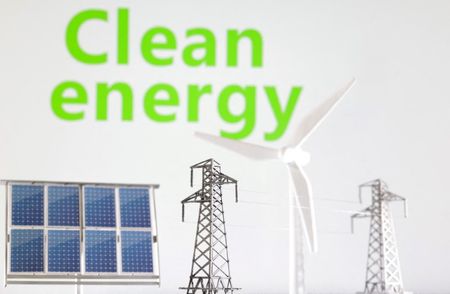By Bansari Mayur Kamdar
(Reuters) – The biggest U.S. ETF tracking clean energy shares was on track for record annual outflows as a rapid rise in interest rates, surging raw materials costs and supply chain disruptions make the fund less attractive to investors.
The iShares Global Clean Energy ETF has reported over $1 billion in net outflows so far this year, according to Lipper data.
The one-time pandemic favorite had seen net inflows of over $2 billion each in 2020 and 2021, but investors have since exited the ETF in the face of higher interest rates.
Tom Bailey, head of research at ETF provider HANetf, said higher rates mean future earnings for growth stocks are discounted and financing projects like solar become more expensive.
The clean energy ETF has fallen 30% so far this year, underperforming a 3% dip in the broader Energy Select Sector SPDR Fund.
Net assets of the iShares fund have nearly halved to $2.7 billion from the start of the year, compared with a 4.5% slip in the net assets of the $38.2 billion SPDR fund.
The Invesco Solar ETF shed 38% so far this year and is also on track to post record annual outflows since the fund’s launch in 2008, having shed $264.6 million, as elevated raw material costs and project delays also weigh.
Solar energy facilities accounted for two-thirds of clean power project delays since late 2021, according to an analysis from the American Clean Power Association, in part due to U.S. import restrictions on panels.
Turmoil has also deepened in the U.S. offshore wind industry, as developers like Orsted seek to renegotiate or cancel contracts, citing soaring costs, and take multi-billion dollar writedowns on projects.
“As the interest rates are still supposed to remain relatively high and the situation in the materials markets remains uncertain, investors should be wary of further writedowns on legacy projects,” said Kamil Sudiyarov, product manager at VanEck.
Uranium-linked ETFs have rallied as prices of the metal soar, defying weakness in the alternative energy space, with the Global X Uranium ETF jumping 45% so far this year and receiving $278 million in net inflows year-to-date.
“A decade of under-investment by miners amidst the 2010s uranium bear market has left supply very tight,” HanETF’s Bailey said.
“This supply squeeze has sent uranium prices higher, which is good news for the earnings potential of uranium miners.”
(Reporting by Bansari Mayur Kamdar in Bengaluru; Editing by Sweta Singh and Anil D’Silva)






